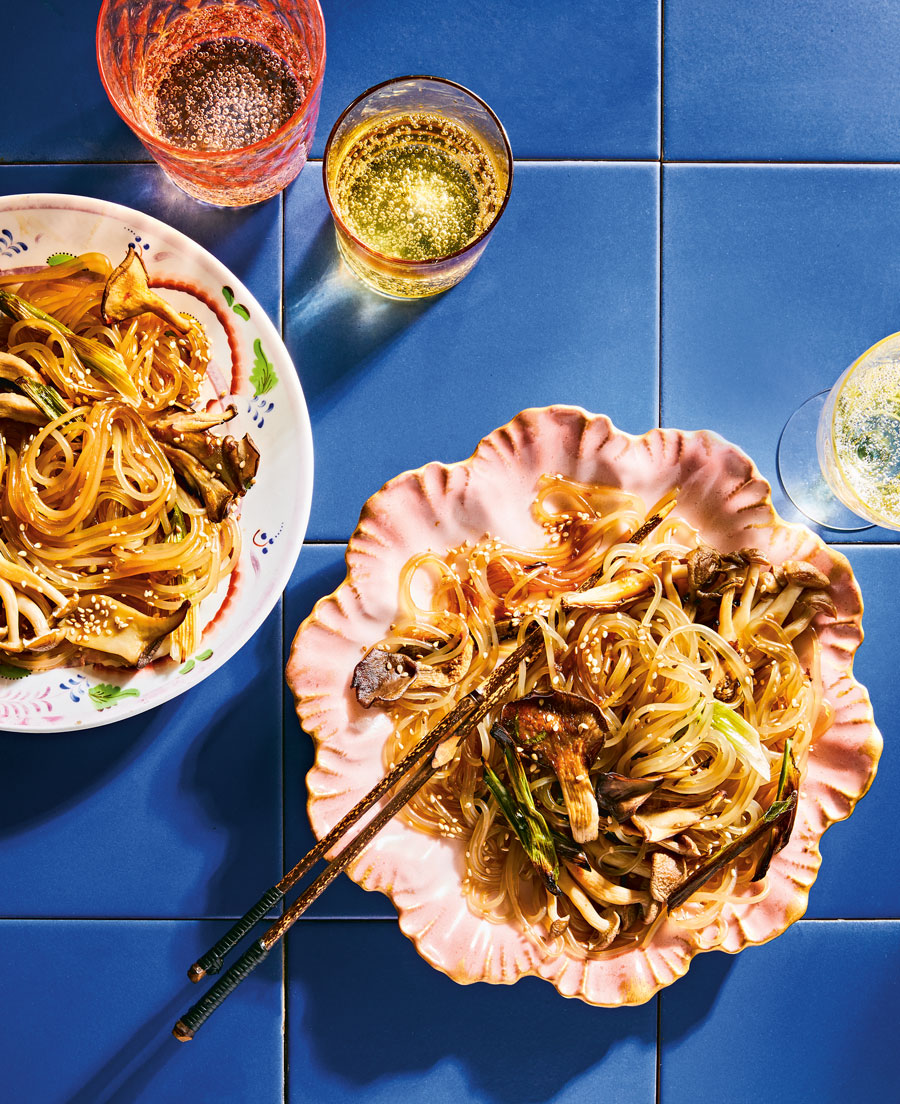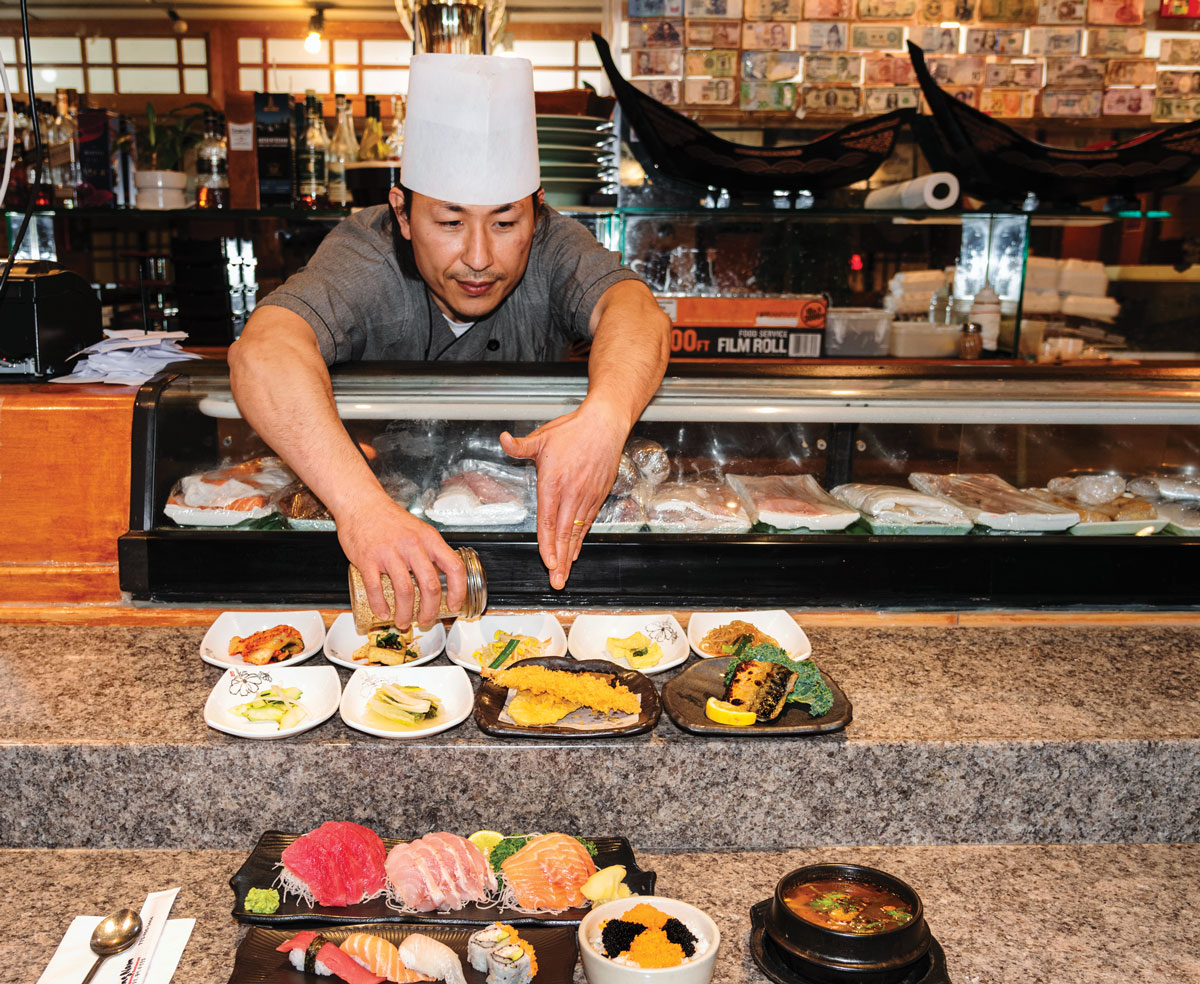
© 2022 Jenny Huang. Published by Clarkson Potter, an imprint of Random House.
For his debut cookbook, Eric Kim originally planned to tour other cities and ask other people’s families what they ate. He’d already published work that touched on the Atlanta area, where he was born and raised: In 2018, for instance, writing for Food52, he prefaced a recipe for his mother’s kimchi fried rice with the story of coming out to his parents over salmon skin rolls and hot sake at Sushi Yoko in Norcross. But Kim—nowadays a New Yorker, and a columnist for the New York Times—changed the book’s premise during the pandemic, when he spent nine months in lockdown with his family in the northern suburbs. “Being back home made me realize how much of myself was still in this city that I took for granted until recently,” Kim says.
Korean American: Food That Tastes Like Home expands upon his family’s history, which is intertwined with the growth of metro Atlanta’s Korean population, the largest in the South. Kim’s book reinterprets the KFC biscuit that his father sought out after arriving in Georgia in 1983. In some recipes, like one for chicken tacos, jalapeños stand in for kkwarigochu (aka shishito) peppers because his parents didn’t have access to the latter—at least, until the neighborhood H Mart arrived. The crispy lemon-pepper bulgogi is, of course, inspired by lemon pepper’s “deep and passionate fanbase in Atlanta.” And the desserts chapter begins with the story of White Windmill, the local pastry chain and gathering spot for Korean immigrants like Kim’s mother, Jean.
“This book isn’t just about Jean, or my family, or Korean American home cooking,” Kim writes. “It’s a love letter to Atlanta as well. A place, a feeling, a time period.” I asked him to tell me about a few Atlanta-area spots that inspired Korean American.
Sushi Yoko
[State Route] 141 is our yellow brick road. You pass by Oasis [Goodtime Emporium] and Krystal, which is so good when you’ve had a little to drink. It’s nice to have those staples, and Sushi Yoko was our staple. My parents work on Buford Highway, and our church was there, so it was always on the way. My mom would say, “I don’t feel like working today. Should we stop by Sushi Yoko?” I’m like “Yeah!” and she’d do a sharp right to go. 7124 Peachtree Industrial Boulevard, Norcross

Photograph by Andrew Lyman
Kani House
It’s fun to do the stupid hibachi dance and have shrimp thrown into your mouth. But really, the reason I love going is because of that high heat, like with kalbi. You can only get that kind of char on zucchini and onions there because of that fire on that griddle. 10820 Abbotts Bridge Road, Duluth
Sumo Hibachi & Wings
Korean fried chicken stays crunchy because it’s double fried and the sugar in the glaze candies a little bit. It’s like [Aunt Georgia’s] Soy Sauce Fried Chicken [with Jalapeños] in my book. But Sumo’s glaze is special. They use lemon pepper and juice, but what they do different is that they use lemon extract. Koreans make fruit syrups by letting fruit cure with sugar for a long time. If you cook lemon juice and reduce it, it loses that brightness. So, it’s genius to use this Korean syrup. 5450 Peachtree Parkway, Peachtree Corners, 678-691-5884

Photograph by Andrew Lyman

Photograph by Andrew Lyman
Kang Nam
During the pandemic, we’d order their sushi platters. But when you’re there, you order the set menu. They give you hobakjuk first—I love this porridge because it’s pure kabocha squash flavor. You might have it at your grandmother’s place, but no one else makes it anymore because it takes forever. They bring out albap, which I do have a version of in my book. Theirs is basic, which is the best way, honestly: It’s rice, sesame oil, and multicolored flying fish roe, where each roe has a different flavor. 5715 Buford Highway, Doraville

Photograph by Andrew Lyman
Buford Highway Farmers Market
I started my job [at the Times] in Atlanta back in February [2021]. I was testing recipes for my colleague, the Nigerian food writer Yewande Komolafe. I had to find red palm oil, really specific root vegetables, and ingredients I wouldn’t be able to find anywhere else. Buford Highway Farmers Market isn’t just a place to get those things; it’s a place for these communities to also have that connection to home. 5600 Buford Highway, Doraville
Recipes
Sheet-Pan Japchae with Roasted Wild Mushrooms
Serves 4 to 6
8 ounces dried dangmyeon (sweet potato noodles)
1 pound wild mushrooms, such as oyster, shiitake (stems removed), and chanterelle, torn into bite-size pieces
5 large scallions, cut into 3-inch lengths
Olive oil
Kosher salt and freshly ground black pepper
2 tablespoons plus 1 teaspoon soy sauce
1 tablespoon toasted sesame oil
1 tablespoon dark brown sugar
1 tablespoon maple syrup
1 large garlic clove, finely grated
Toasted sesame seeds, for serving
- Position a rack as close to the broiler element as possible and preheat the broiler.
- Bring a large pot of water to a boil and cook the dangmyeon according to package directions.
- Meanwhile, arrange the mushrooms and scallions on a sheet pan and toss with some olive oil. Place under the broiler and roast until deeply caramelized and crispy, about 5 minutes. Watch them carefully. Remove the pan from the oven and season with salt and pepper.
- In a small bowl, whisk together the soy sauce, sesame oil, brown sugar, maple syrup, and garlic. When the noodles are done cooking, drain them and add them directly to the sheet pan with the roasted mushrooms. Pour the dressing over the noodles and toss everything together with tongs.
- To serve, transfer the japchae to a large platter and sprinkle with sesame seeds.

© 2022 Jenny Huang. Published by Clarkson Potter, an imprint of Random House.
Crispy Lemon-Pepper Bulgogi with Quick-Pickled Shallots
Serves 4
Grated zest and juice of 1 large lemon
2 shallots, thinly sliced
Kosher salt
1 tablespoon black peppercorns
1 teaspoon demerara sugar (such as Sugar in the Raw)
½ teaspoon garlic powder
1 pound thinly sliced rib eye (or other meat for bulgogi-style dishes; see Tip)
Vegetable oil
1 jalapeño, thinly sliced into rings
Fresh cilantro leaves plus tender stems, lots of it
Cooked white rice, for serving
- Preheat the oven to 170°F.
- Evenly spread out the lemon zest on a sheet pan and bake until completely dried out, 20 to 30 minutes.
- Meanwhile, mix the lemon juice and shallots in a small bowl, season with salt, toss, and set aside to quick-pickle.
- Add the dried-out lemon zest and the black peppercorns to a spice grinder or mortar/ pestle and grind until coarse. Transfer to a small bowl and stir in 1 teaspoon salt, the demerara sugar, and garlic powder.
- Use a paper towel to pat the meat dry and lay it out on a cutting board or sheet pan in a single layer. Season both sides with the lemon pepper.
- Heat a large grill pan or skillet until very, very hot (you may see a wisp of smoke rise from the surface) and add enough oil to lightly coat the bottom. Add the bulgogi to the pan in a single layer and cook until crispy and well browned, about 1 minute on the first side and literally a few seconds on the second. You may need to work in batches so as not to overcrowd the pan. Transfer to a plate and top with the pickled shallots, jalapeno, and cilantro. Serve with white rice.
Tip If you can’t find bulgogi-style beef, then you can just do it yourself: Place a boneless rib eye in the freezer for a few minutes to firm up, then slice thinly with a very sharp knife.
Sheet-Pan Version Instead of pan-searing, you could actually drizzle some oil over the meat and broil it on the top rack until crispy and well browned, 2 to 3 minutes (just watch it carefully so it doesn’t burn). This will only work with broilers that run very hot—if you suspect yours doesn’t, then stick to the pan-searing method in the recipe.
Recipes reprinted from Korean American. Copyright © 2022 Eric Kim.
This article appears in our May 2022 issue.
The post The metro Atlanta spots that inspired Eric Kim’s cookbook, Korean American: Food That Tastes Like Home appeared first on Atlanta Magazine.
